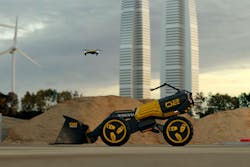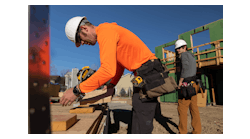Over time, the job profile will evolve and become a core part of an operator’s skill set. - Erol Ahmed, Built Robotics
On days when I spend more time in the car than my office, the freeway helps keep me current on what’s going in the world. Lucky for me that L.A.’s all-news station repeatedly repeats itself, and if I miss something the first time it airs, I can pick it up when it comes around again. So it was that on a recent trip from L.A. to Orange County, I heard (repeatedly) about troubles brewing at Amazon. Although fuzzy on the details, it appeared that the problem was at the “human-machine interface” where warehouse personnel and Amazon’s 200,000 robots “interact.”
Amazon’s troubles brought me back to the introduction of automatic flight controls in commercial aviation. Flying by wire wasn’t so much of an issue for younger pilots who had largely grown up with computers, but their older compatriots, many of whom had come out of the military where they learned to control an aircraft by feel (and very proud of it, thank you), saw computerization as a threat. A similar dynamic surfaced when heavy equipment manufacturers rolled out machine control. Job loss was a concern in both groups who worried that the value of skills they had spent years honing was being denigrated.
In both aviation and the heavy equipment industry, the rationale for linking humans with machines was couched in terms of safety, consistency, and productivity. (The commercial airline industry was even so bold as to suggest that what it had on its mind was the elimination of pilot error). Older airline pilots eventually adapted to having a computer between themselves and an airplane’s flight controls, just as heavy equipment operators eventually warmed to the advantages of computer-assisted operation. Nevertheless, the transition in both industries could have gone a lot more smoothly if more attention had been paid to the effects of human-machine interaction.
In the early days when automation came strolling in trailing a host of benefits, computers were seen as a tool, servant to human dream making. Today’s visionaries who continue to push technology ever forward have hewn close to the argument that their increasingly complex digital tinkering keeps us humans safer eliminates the more mundane aspects of our jobs and increases our productivity. Not to mention that taking the work out of work frees us to pursue more creative pursuits and develop the skills that keep us moving up the ladder.
(I’ve always wondered what would happen to people at the top if everyone below them who was qualified to move up, did. Would we be looking at a revised charter for human resource departments that involves defining the elements of job satisfaction and passing judgment on which operations in an organization can benefit from a shot of human ingenuity and imagination?)
Sad to say that in the race toward safety, consistency, and a predictable bottom line, attention has not been applied equally to both sides of the equation. Observers studying the dynamics of human-machine interaction have warned that the short end of the stick is falling dangerously close to home—that as we humans proceed down the road of computer assistance (in company with more efficiently produced goods, more effectively provided services, and generally a more comfortable life), we risk missing the fork in the road that directs away from outright computer dominance. Likewise, we’re reminded that the benefits of work extend beyond a paycheck to include a sense of personal identity and meaning. Moreover, introducing automation prematurely and without adequate safeguards may lead to a loss of psychomotor skills, changes in brain function, and reduction in cognitive decision-making. (Whew!)
So it was that I wasn’t surprised that the problems at Amazon had emerged at that ragged juncture between humans and machines. Researchers are wont to suggest that we shouldn’t jump the gun and blame robots per se—or inadequately trained workers—when the problem may be a function of impractical production goals and the application of artificial intelligence (AI) to keep both man and machine on the straight and narrow. It’s ironic to note that in the application of advanced technology, humans are increasingly cast in the role of “minder” (that's British for someone who manages something), relegated to keeping their robotic charges from running off the rails.
In its introduction of remote-controlled and self-operating machines, the heavy equipment industry has adopted that well-worn paradigm of safety, consistency, and efficiency. In 2016, Caterpillar dubbed this the era of “smart iron” and characterized its mining customers as having experienced a “step-change” in safety.
Although Caterpillar has yet to make semi-autonomous or autonomous machines available to the construction industry, autonomous trucks and drills are up and running in mining in company with remote-controlled dozers and underground loaders. CAT Command for dozers allows a single operator to remotely control multiple machines simultaneously.
Currently, a “run team” of Caterpillar Global Mining personnel is dispatched onsite when a mine opts for autonomous machines to assist in setup and initial operations. Team members sit at consoles monitoring system operation and making adjustments as necessary. They also train mine employees. Additionally, operators tapped to be machine “controllers” must also complete a catalog of industry-specific courses.
While Volvo has yet to make semi-autonomous or autonomous equipment available commercially, it is investigating fifth-generation (5G) data transmission, which it considers essential for the smooth operation of remote control and self-operating technology. In partnership with Telia Sweden telecommunications, it is currently testing a 5G-equipped remotely controlled conventional wheel loader and its HX2 concept wheel loader.
Meanwhile, interlopers from outside the industry are moving in. Built Robotics, founded by two young entrepreneurs, upgrades off-the-shelf heavy equipment with AI guidance systems that enable machines to operate autonomously. The technology is OEM agnostic and does not depend on pre-existing hardware.
“We listen very closely to the construction industry,” says spokesperson Erol Ahmed. “Our most popular upgrades have been to excavators, bulldozers, and CTLs/skid-steers. This equipment is fully autonomous.”
Based on experience thus far, Built Robotics considers robots the best suited for repetitive tasks, which (guess what?) frees humans to engage in more meaningful work; improves employee safety by replacing humans with machines in dangerous situations; and links remote job sites with other company operations.
Built Robotics uses three layers of what it calls redundant fail-safes that include wired and wireless emergency stops that stop the machine instantly at any point in job site operation, a physical and virtual geofence that locks a machine into a specific space, and sensors and cameras that make it possible for machines to sense and avoid onsite obstacles in real-time.
Ahmed stresses the importance of training to the successful application of autonomous technology. “Built Robotics is working with its customers to develop appropriate curriculum and training regimes to help operators up-skill into this new field of robotics.
“Each of our partners has approached the challenge of autonomous operation differently. Some have dedicated innovation teams that are tasked with testing, advocating, and deploying ‘frontier technologies’ in their organizations. Other partners have existing teams—usually IT or operations—that take on additional responsibilities for innovating within an organization. Each of those teams works closely with existing operators, foremen, project planners, and job site superintendents to develop the best change-management process for using robots. After the right team and job site are selected, our partners work with us in training and setting up the robots on specific tasks.”










